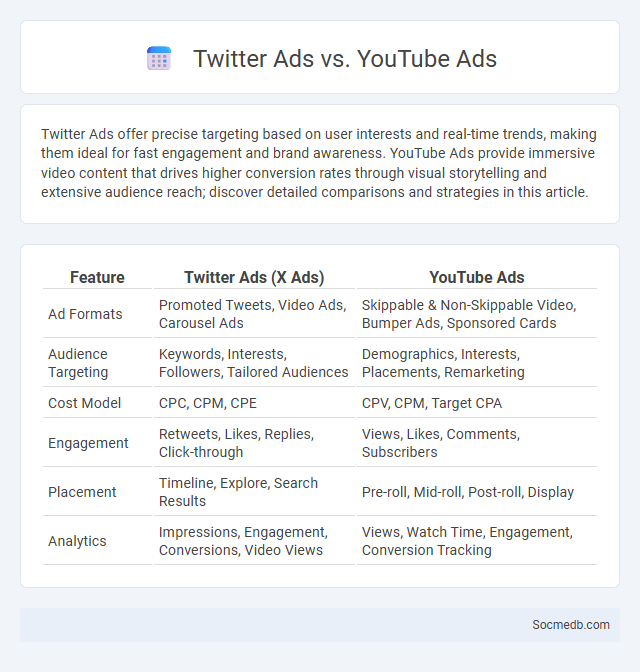
Photo illustration: Twitter Ads vs YouTube Ads
Twitter Ads offer precise targeting based on user interests and real-time trends, making them ideal for fast engagement and brand awareness. YouTube Ads provide immersive video content that drives higher conversion rates through visual storytelling and extensive audience reach; discover detailed comparisons and strategies in this article.
Table of Comparison
| Feature | Twitter Ads (X Ads) | YouTube Ads |
|---|---|---|
| Ad Formats | Promoted Tweets, Video Ads, Carousel Ads | Skippable & Non-Skippable Video, Bumper Ads, Sponsored Cards |
| Audience Targeting | Keywords, Interests, Followers, Tailored Audiences | Demographics, Interests, Placements, Remarketing |
| Cost Model | CPC, CPM, CPE | CPV, CPM, Target CPA |
| Engagement | Retweets, Likes, Replies, Click-through | Views, Likes, Comments, Subscribers |
| Placement | Timeline, Explore, Search Results | Pre-roll, Mid-roll, Post-roll, Display |
| Analytics | Impressions, Engagement, Conversions, Video Views | Views, Watch Time, Engagement, Conversion Tracking |
Overview of Twitter Ads, YouTube Ads, and Ad Campaigns
Twitter Ads allow you to target specific audiences through promoted tweets, video ads, and follower campaigns, leveraging real-time engagement and trending topics. YouTube Ads offer diverse formats such as skippable in-stream, non-skippable, and bumper ads, enabling precise demographic targeting and visual storytelling for stronger brand impact. Effective ad campaigns integrate both platforms to maximize reach, optimize ad spend, and enhance user interaction across social media channels.
Audience Targeting Capabilities Comparison
Social media platforms vary significantly in audience targeting capabilities, with Facebook Ads offering advanced options like detailed demographic filters, behavior-based targeting, and lookalike audiences to optimize reach. Instagram leverages its integration with Facebook's system for precise interest and engagement-based targeting, while LinkedIn excels in professional targeting by allowing advertisers to focus on job titles, industries, and company sizes. Twitter provides keyword targeting and conversational filters, although its granularity is generally less comprehensive compared to Facebook and LinkedIn's detailed profiling tools.
Ad Formats and Creative Opportunities
Social media platforms offer a diverse range of ad formats including carousel ads, video ads, and sponsored posts, each designed to maximize engagement and conversion rates. Creative opportunities abound with interactive elements like polls, augmented reality filters, and shoppable posts that captivate audiences and drive brand interaction. By leveraging these dynamic ad formats, your campaigns can achieve higher visibility and resonate more deeply with target demographics.
Cost Structures and Budgeting Differences
Social media cost structures vary significantly depending on platform choice, ad formats, and campaign objectives, with expenses ranging from pay-per-click to fixed monthly fees. Your budgeting strategy must account for content creation, paid promotion, and ongoing analytics tools to optimize return on investment. Understanding these differences helps allocate resources effectively and maximize social media ROI.
Performance Metrics and Analytics
Performance metrics and analytics in social media provide critical insights into engagement rates, reach, and conversion tracking, enabling precise evaluation of your campaign effectiveness. Leveraging data from platforms like Facebook Insights, Twitter Analytics, and Instagram Insights helps optimize content strategy by revealing audience behavior and preferences. Monitoring key performance indicators (KPIs) such as click-through rates, follower growth, and sentiment analysis empowers you to make data-driven decisions that enhance social media ROI.
Engagement Rates: Twitter vs YouTube vs Other Campaigns
Engagement rates on social media campaigns vary significantly, with Twitter typically achieving an average engagement rate of 0.5% to 1.5%, while YouTube often exceeds these figures, averaging 2% to 5% due to video content's immersive nature. Other platforms like Instagram and Facebook show engagement rates ranging from 1% to 3%, influenced by content type and audience demographics. Analyzing platform-specific data reveals YouTube campaigns generally generate higher user interaction, driven by longer content duration and visual storytelling effectiveness.
Industry-Specific Effectiveness
Social media platforms demonstrate varying levels of effectiveness depending on the industry, with B2B companies excelling on LinkedIn due to targeted professional networking. Retail and fashion brands significantly boost engagement and sales through visually-driven channels like Instagram and Pinterest. Your marketing strategy should align with industry-specific trends to maximize reach and conversion rates on each platform.
Pros and Cons of Each Advertising Platform
Facebook offers extensive targeting options and a vast user base ideal for brand awareness and lead generation, but its organic reach has declined, requiring higher ad spend to achieve visibility. Instagram excels in visual storytelling and influencer partnerships, driving strong engagement among younger audiences, though competition is fierce and ad costs can be high. LinkedIn provides precise B2B targeting and professional audience insights, making it effective for lead generation and recruitment despite higher CPC rates and a smaller user base compared to other platforms.
Best Practices for Maximizing ROI
Implementing targeted content strategies on social media platforms enhances audience engagement and conversion rates, driving higher ROI. Leveraging analytic tools such as Facebook Insights and Google Analytics allows businesses to track campaign performance and optimize advertising spend effectively. Consistent brand messaging across channels combined with timely interaction increases customer loyalty and amplifies return on investment.
Choosing the Right Platform for Your Marketing Goals
Selecting the right social media platform depends on your target audience demographics and content type, aligning with platforms like Instagram for visual branding or LinkedIn for B2B networking. Analyze platform engagement rates and advertising options to maximize your marketing ROI. Tailoring your strategy to platform-specific algorithms and user behavior enhances campaign effectiveness and brand visibility.
 socmedb.com
socmedb.com